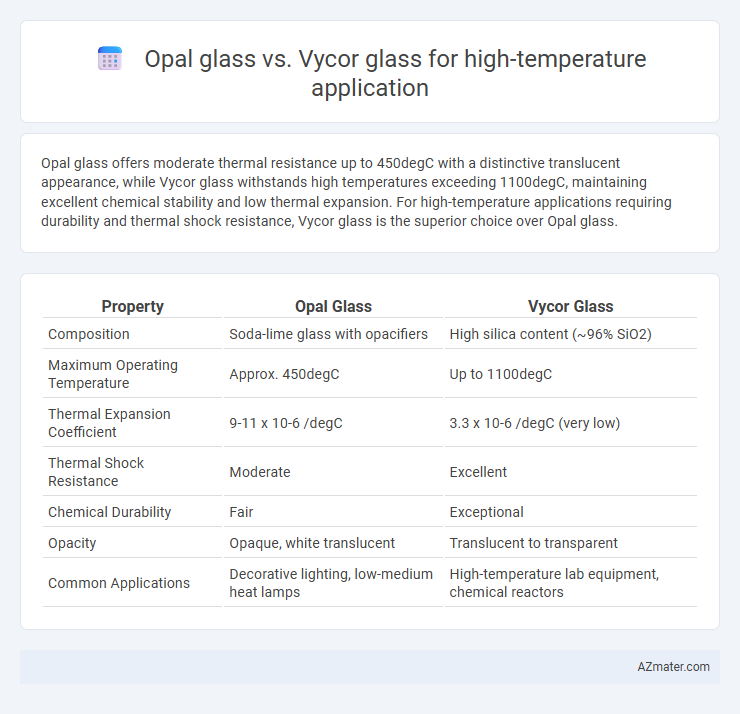Opal glass offers moderate thermal resistance up to 450degC with a distinctive translucent appearance, while Vycor glass withstands high temperatures exceeding 1100degC, maintaining excellent chemical stability and low thermal expansion. For high-temperature applications requiring durability and thermal shock resistance, Vycor glass is the superior choice over Opal glass.
Table of Comparison
| Property | Opal Glass | Vycor Glass |
|---|---|---|
| Composition | Soda-lime glass with opacifiers | High silica content (~96% SiO2) |
| Maximum Operating Temperature | Approx. 450degC | Up to 1100degC |
| Thermal Expansion Coefficient | 9-11 x 10-6 /degC | 3.3 x 10-6 /degC (very low) |
| Thermal Shock Resistance | Moderate | Excellent |
| Chemical Durability | Fair | Exceptional |
| Opacity | Opaque, white translucent | Translucent to transparent |
| Common Applications | Decorative lighting, low-medium heat lamps | High-temperature lab equipment, chemical reactors |
Overview of High-Temperature Glass Applications
High-temperature glass applications require materials with exceptional thermal stability, resistance to thermal shock, and chemical durability. Opal glass, known for its diffused light transmission and moderate heat resistance up to approximately 450degC, is typically used in decorative and low-heat environments. In contrast, Vycor glass offers superior performance with a high melting point around 1650degC, excellent thermal shock resistance, and high chemical inertness, making it ideal for advanced laboratory equipment, industrial kilns, and high-temperature insulation.
What is Opal Glass?
Opal glass is a type of borosilicate glass characterized by its milky white, translucent appearance, achieved by the inclusion of opacifiers such as tin dioxide or zirconium oxide. It offers excellent thermal shock resistance and can withstand high temperatures up to approximately 500degC, making it suitable for certain high-temperature applications like laboratory glassware and lighting fixtures. Compared to Vycor glass, which contains over 96% silica and withstands temperatures up to 900degC, opal glass has lower thermal tolerance but provides better diffusion of light due to its opaqueness.
What is Vycor Glass?
Vycor glass is a high-purity, high-temperature resistant glass composed primarily of 96% silica, engineered for superior thermal stability and low thermal expansion. Unlike opal glass, which contains dispersed particles that scatter light and can degrade under high heat, Vycor maintains its structural integrity and optical clarity at temperatures up to 900degC. Its exceptional resistance to thermal shock and chemical corrosion makes Vycor ideal for applications requiring sustained exposure to extreme heat.
Thermal Resistance: Opal Glass vs Vycor Glass
Vycor glass demonstrates superior thermal resistance compared to opal glass, withstanding temperatures up to 900degC due to its high silica content and low thermal expansion coefficient. Opal glass, while aesthetically appealing with its translucent properties, typically tolerates temperatures only up to 450degC before deformation or cracking occurs. The enhanced thermal stability of Vycor glass makes it more suitable for demanding high-temperature applications such as laboratory equipment and industrial processes.
Chemical Durability Comparison
Opal glass exhibits moderate chemical durability with resistance to most acids but tends to degrade under strong alkalis and hydrofluoric acid, limiting its use in highly corrosive high-temperature environments. Vycor glass, a high-silica glass with over 96% SiO2 content, offers superior chemical resistance, particularly against alkaline and acidic solutions, making it ideal for demanding high-temperature applications requiring robust chemical stability. The exceptional chemical durability of Vycor glass also contributes to its enhanced thermal shock resistance and longevity compared to opal glass in harsh industrial conditions.
Mechanical Strength and Durability
Opal glass offers moderate mechanical strength and thermal stability, making it suitable for applications with temperatures up to around 200degC, but it tends to be less durable under thermal shock compared to Vycor glass. Vycor glass, primarily composed of high-purity silica, exhibits exceptional mechanical strength and durability, maintaining structural integrity at temperatures exceeding 1000degC due to its low thermal expansion and high resistance to thermal shock. Vycor glass's superior durability and mechanical performance under high-temperature conditions make it the preferred choice for demanding industrial and scientific applications.
Transparency and Optical Properties
Opal glass exhibits diffuse light transmission with a milky appearance, making it less suitable for applications requiring high optical clarity at elevated temperatures. Vycor glass, a high-purity silica-based material, maintains exceptional transparency and minimal light scattering even at temperatures exceeding 1000degC, making it ideal for high-temperature optical applications. The superior thermal stability and consistent refractive index of Vycor glass ensure reliable optical performance under extreme conditions, unlike the translucent and lower clarity nature of opal glass.
Cost and Availability Analysis
Opal glass typically offers a lower-cost solution compared to Vycor glass, making it more accessible for budget-sensitive high-temperature applications. Vycor glass, known for its exceptional thermal stability and resistance to thermal shock, is often more expensive and less widely available due to its specialized manufacturing process. The cost-effectiveness of opal glass is balanced by Vycor's superior performance in extreme temperature environments, requiring consideration of specific application demands and supply chain factors.
Typical Applications in High-Temperature Environments
Opal glass is commonly used in high-temperature laboratory settings for its excellent thermal shock resistance and diffused light transmission, making it suitable for furnace windows and heating elements. Vycor glass, composed of high-silica content, offers superior thermal stability and chemical durability, ideal for applications such as high-temperature chemical reactors, optical devices, and infrared spectroscopy windows. Both materials withstand temperatures up to 1100degC, but Vycor's enhanced purity and structural integrity provide extended service life in extreme thermal environments.
Choosing the Right Glass: Opal or Vycor?
Vycor glass offers superior thermal stability and can withstand temperatures up to 1100degC, making it ideal for high-temperature applications requiring durability and resistance to thermal shock. Opal glass, while visually appealing with its translucent quality, has a lower maximum operating temperature, typically around 450degC, limiting its use in high-heat environments. Choosing Vycor over Opal glass ensures enhanced performance in applications involving extreme heat, such as laboratory equipment and industrial processes.

Infographic: Opal glass vs Vycor glass for High-temperature application
 azmater.com
azmater.com